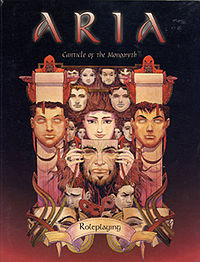 A guest post by Martin Greening
A guest post by Martin Greening
Most of the articles this month on The Fictorian Era have focused on inspirational video games. I have to admit, as an IT guy, I’m pretty low tech and really don’t play too many of those other than an occasional jump into Star Wars The Old Republic or Rift. What I do play a lot of are table top roleplaying games, like good old fashioned Dungeons and Dragons. My shelves sag heavily under the weight of my growing roleplaying game collection, with titles like Burning Wheel, Blue Planet, Dungeon World, Traveler, and Aria: Canticle of the Monomyth.
That’s the game I want to talk briefly about today, Aria.
One of the biggest tasks for anyone who wants to write fantasy is worldbuilding (creating the world in which your characters live). It can be a daunting task; creating the people and cultures, political systems, economy, environment, flora and fauna. Where do you start? How do you keep it sensible so the reader doesn’t say “whatever” and stop reading your story? And readers are smart. They will find the inconsistencies in your world.
That’s where Aria comes in. The game was published in 1994 by Last Unicorn Games (sadly they are no longer in business). Only two books were released, the main rulebook and Aria Worlds. Aria is more of what you might call a metagame, a game about creating a game, or in our case, a game about creating a world. It can be a great tool to guide an author in creating a consistent and logical setting for their stories. How does it do this? Typically, most table top roleplaying games assign numerical values to a character so their abilities are easier to determine in comparison to another character’s. Aria does this same thing, but not only with characters, Aria does it with any entity: nations, cultures, etc. This is especially true for the Aria Worlds book, which outlines a method of creating a logical and consistent society.
The book begins by asking about the foundations of that society. What is their primary orientation? Conquest? Survival? How much interaction does that society have with neighboring societies? From there the book guides you towards the societies technology level and their tendencies to innovate and assimilate. These aspects of a society are used to determine what is their likely subsistence pattern, which in turn directly relates to the society’s mobility. For example, a society that has developed metalworking is more likely to be a sedentary agricultural society. The chapters in Aria Worlds then move into politics and kinship, economy, military, religion, arts, scholastics, magic, and end with the development of the society’s hierarchy of social estates. Each of these aspects can be rated on a scale of 1 to 10 for easy comparison with other societies.
The main Aria rulebook also covers the hierarchy of social estates and a very general look at the other topics in Aria Worlds, but it also has chapters on the nature of magic and what they call heritage. The chapter on magic provides interesting guidance on creating the magic system for a world, including its origins and nature, along with the repercussions of those who utilize magic. Heritage is a term used to incorporate both species and culture since they are often intertwined. The heritage chapter outlines some of the aspects of culture that are covered in Aria Worlds, but also discusses species creation, which can be very useful when creating the non-humans that populate your world.
And for more inspiration there’s the artwork in both books. The covers by Michael Kuleta are stunning and the interior design and art will tickle anyone’s muse.
Being out of print, it may be difficult to find either of the Aria books, but the hard search is definitely worth it as inspiration in building your own story worlds.
 Martin Greening hails from Southern California and has been drawn to fantasy and science fiction from a young age. He is currently working on a fantasy adventure novel and several short stories. Martin lives in Sin City working as a IT guru by day and a dreamer of the fantastic at night. He can be found at his webpage.
Martin Greening hails from Southern California and has been drawn to fantasy and science fiction from a young age. He is currently working on a fantasy adventure novel and several short stories. Martin lives in Sin City working as a IT guru by day and a dreamer of the fantastic at night. He can be found at his webpage.

I haven’t tried Aria, but sounds interesting, especially for someone just stepping into the worldbuilding jungle for the first time. It can be pretty intimidating.